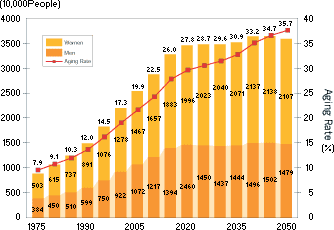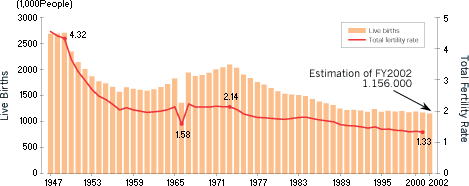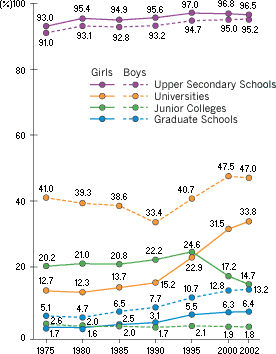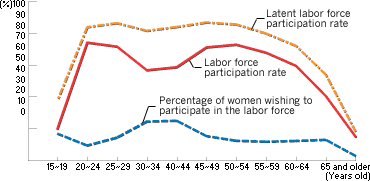![]()
Present Status of Japanese Women
- Present Status of Japanese Women
- Population
The birthrate in Japan is declining and its population is ageing. The total fertility rate (the total live birthrate for women in all age groups for that year, in other words, it refers to the number of births per woman during her lifetime) has continued to decline since it fell below 2.00 in 1975. The increase in the percentage of unmarried persons is thought to be one of the factors behind the decline in Japan's total fertility rate.
The average age at first marriage has risen annually and stood at 29.0 years for men and 27.2 years for women in 2001. Approximately half of Japanese women in their late 20s, the age group that used to enjoy the highest birthrate, remained unmarried. The lifelong single rate (the percentage of people still single at 50 years of age) has increased dramatically since 1960, particularly for men.
The aging rate (the proportion of the total population aged 65 years or older) has also risen rapidly. The declining birthrate and greater life expectancy are thought to be the main factors behind the aging of society. The average life expectancy of women was 84.93 years in 2001 and that of men was 78.07 years.
CHANGES IN THE AGING RATE AND
POPULATION AGED 65 YEARS AND OVER
(Sources)
Until 2000: Popuation Census, Ministry of Public Management, Home Affairs, Posts and Telecommunications; 2005 onwards:Population estimates for 1 October of each year (middle estimate)taken from Future Population Estimates for Japan (Jan. 2002 Estimates), Japan Institute of Social Insurance and Population IssuesTRENDS IN THE LIVE BIRTHS AND THE TOTAL FERTILITY RATE

(Sources)
"Vital Statistics of Japan", Ministry of Health, Labor and Welfare - Education
The percentage of students advancing into high school in Japan is extremely high, with the percentage of girls exceeding that of boys.
Although the majority of boys advancing into institutions of higher education enter universities (undergraduate), girls may advance into either universities (undergraduate) or junior colleges. However, the trend in recent years has been for the percentage of girls advancing into universities (undergraduate) to increase and their advancement into junior colleges to decline. Moreover, their major fields of study are diversifying.
TRENDS IN FEMALE AND MALE
ADVANCEMENT INTO SCHOOLS
BY SCHOOL CATEGORY
(Sources)
"School Basic Survey", Ministry of Education, Culture, Sports, Science, and Technology - Employment
The labor force participation rate of women in Japan remains an M-shaped curve with their participation declining due to marriage, childbirth and child raising. Women's aspirations to work are not being realized although many women have a great desire to work throughout their childbirth/child raising years. The latent labor force participation rate, which adds of the number of unemployed women who wish to work to the labor force population, approximates an upside down U-shaped curve. Looking at how Japanese couples spend their time, we see that regardless of whether or not their wives work, husbands spend little time on housework, raising children or care for the elderly. As a result, working wives have to shoulder both their responsibilities at home and at work.
Diversification of work patterns may be given as a distinguishable change in recent employment. The proportion of the labor force engaged in work patterns other than regular employees, including part-timers, dispatch workers and contract workers, has increased, and this trend is particularly noticeable among women.
WOMEN'S LATENT LABOR FORCE PARTICIPATION RATE
AVOIDS AN M-SHAPED CURVE
Notes:
Latent labor force participation rate by age-bracket = Population of the labor force (by age-bracket) + Population of the non-working population that want to work (by age-bracket) / Population aged 15 years and over (by age-bracket)Sources:
Special Survey of the Labor Force Surveys (August 2001), Ministry of Public Management, Home Affairs, Posts and TelecommunicationsUSAGE OF TIME BY MARRIED COUPLES

Notes:
Primary activities refer to activities essential to daily life such as sleeping and eating.Secondary activities refer to activities of a highiy obligatory nature undertaken as part of our social lives and encompass work and housework.Tertiary activities refer to activities not included in the above that individuals participate in during their free time."Nursing" and "shopping" are included in "housekeeping,childcare,etc".Sources:
"2001 Survey on Time Use and Leisure Activities", 2001, Ministry of Public Management, Home Affairs, Posts and Telecommunications - Agriculture, Forestry and Fisheries Industries
Japanese women accounted for 55.5% of the total labor force engaged in agriculture in 2002, 14.3% in forestry in 2002 and 16.9% in the fisheries in 2000. Women engaged in agriculture, forestry and fisheries play an important role in their respective industries and contribute greatly to the management of their respective lifestyles and to the maintenance and revitalization of their local communities. Looking at the status of women's participation in local policy decision-making processes reveals that the percentage of female members of agricultural committees responsible for organizing matters pertaining to the use of farmland remains at a low level. Notwithstanding, this percentage has increased from 0.80% in 1998 to 1.64% in 1999 and 1.82% in 2000, and the trend is for this to rise gradually.
- Population
